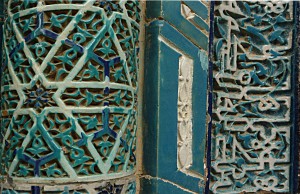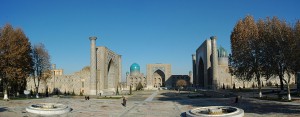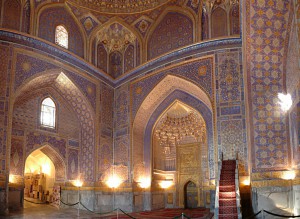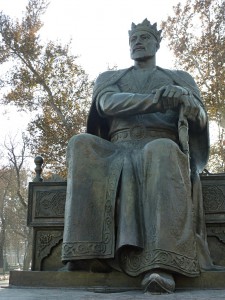One destination which appears on almost every itinerary through Central Asia is Samarkand. Timer made the city the capital of his empire in the 14th century, which reached all the way to modern day Istanbul. Today the city is known for its beautiful buildings, which survived many a storm during the past centuries.
Punctually at 11 o’clock the Sharq Express from Bukhara arrived in Samarkand. It was good to know when the train would be arriving, since there were no announcements and I almost missed the stop. Rapidly I grabbed my belongings and got off the train. The first thing that struck me was the terrible weather. It was comparable to what one is used to in Southern Germany or Switzerland around this time of the year: a solid cloud cover and light snow with temperatures around 0°C.
My first job was to get rid of all the taxi drivers who wanted to give me a ride to my hotel. I was more interested in getting a train ticket to Tashkent three days later. Since the train station is quite a distance from the city center, this saved some hassle later on. I then took the marshrutka to the Registan in the heart of the city, and the sight for which Samarkand is known. The Bahodir B&B were I would stay the following three nights is just a few steps from the Registan and only 200m from the marshrutka stop.
In Samarkand I repeatedly showed my incapability when it comes to negotiation. I problably bore the salespeople when I accept their prices, which sometimes seem reasonable to me. I still had to learn, to look at haggling as a sort of game, in which the goal not only is to achieve the lowest possible price, but the human interaction. Of course, the money plays a role in this game, but the main thing is to respect the local culture. In Uzbekistan one can negotiate almost every price, from the hotel room to food to entrance prices for tourist sights. I still had to get used to the concept though.
Due to the bad weather I did not have a real goal on this Sunday, but finding some food. I tried to discover the side roads without getting lost without a city map. One can see really well that Samarkand is a touristy city. The Registan and the streets from there to the other tourist attractions, such as the Bibi-Khanym mosque and mausoleum, are constructed similar to pedestrian zones as we know them in Europe. The side rides however are hidden from view by large metal gates. When one is visiting the city on an organized tour, one can get quite a distorted image of the city and the country.
Monday greeted me with a snow-white Samarkand. The day before I had tried to get a reliable weather forecost by checking four websites. Everyone one of them suggested different weather for the following days. But the thin layer of snow made the city also quite attractive, especially considering that one usually gets to see the city with bright sunshine. The orient covered in snow, quite difficult to imagine, isn’t it?
Since the weather did not change much, I decided to visit a few first tourist sights, before I started discovering the new part of the city. The first sight on my radar was the mausoleum of Timur. It is thanks to his successes in the 14th century, with an empire reaching from Central Asia to Istanbul, that Samarkand today is one of the most visited cities in the region. During his reign, some of the most impressive buildings were constructed, among which is his mausoleum, which was originally built for his grandson. The entrance fees for all the sights are indicated in US dollars, but it is definitely worth it paying in Uzbek Som. The prices are converted using the official exchange rate of about 1800 Som for a dollar, while one can change the money on the black market for 2600 Som for a dollar. The mausoleum is an attractive building which contains several tombs of Timur’s family. Additionally there is an information board which shows the extent of Timur’s empire.
Before visiting the new part of the city I visited the Rukhobod mausoleum and passed the statue of Timur. The new city was built during the Sowjet times, which clearly shows in the wide streets and single storey houses. After crossing the boulevard, I reached the Navoi Park. In the summer time, this park offers many possibilities for entertainment. Around this time of the year, everything is closed down. Next to the Navoi Park I happend to stumble upon the first of two churches which I would see on this day. Right behind Navoi Park start the streets where a large part the people of Samarkand are hiding. Contrary to the historical center, one can find many different shops, restaurants, banks, Internet cafés and so on.
Since the National Bank of Uzbekistan has a branch office in one of the streets, I paid some attention on which streets I was hitting to finally find the bank, where I could get some US dollars from my VISA card. First I had to go to a counter, where they had a card reader and thus could charge my card. Once that went through successfully, I received a sort of check, which I could bring to the cash counter to receive the desired amount of cash. I little bit complicated but a process which works without any problems, once one can find the correct counters.
I paid my next visit to an Internet Cafê, since I wanted to get my documents ready for the application of a Chinese visa. I am curious what the real history for getting a Chinese visa will look like in Tashkent. It seems that since a year or two one can get a Chinese tourist visa without a letter of invitation and thus without an agent. Apparently it is sufficient to bringe the visa application form correctly filled out, a photo and proof of legal presence in the country where one is applying for the visa. Since I didn’t want to loose unnecessary time in Tashkent I planned to have everything ready by the time I got there.
In the Internet café I first could conduct my research and look for information undisturbed. I was particularly happy to read to unrelated comments on my blog from Iran. Both of them were made on December 4, such that I declare hereby December 4 as the “Iranian Friendship Day”. About at noon however the peace and quiet come to an abrupt end, which a bunch of kides stormed the Internet café. Their main goal was to play some games on the network, which of course was not possible quietly. Since I had completed my duties I soon left the place.
I enjoyed the atmosphere in the lively streets and the character of the area. The single storey buildings with the small shops and the wide streets leave a lot of room to the people. This is not the claustrophobic feel which one tends to get in midtown Manhattan. After a few rounds through the streets and a few photos I chose a small restaurant where I tried their Laghman soup, a noodle soup with vegetables and meat. The host was a nice and attentative man and we were able to understand each other with only a few words. He appointed me a table in the back room, where two older men were playing chess. The were seriously playing as the play clock on their table indicated. When I looked around I realized that the place probably is a meeting place for chess players. The portraits of all the chess world champions as well as picture from a recent match in Tashkent decorated the room.
Strengthend by the meal I continued my city tour. First I meandered through the new part of town, past the governmental buildings, to arrive in a big arch back at the old town. I realized I was only about 200m from the Registan, but the houses and the environment were quite different from what one would expect as a tourist. The dirt roads and occasional pile of trash indicated this was quite a forgotten part of the city, altough at a very central location.
Finally I ended up at the Siob Bazaar, which I this time left on my right hand side to continue to the next tourist attraction, the Shah-i-Zinda, the “Tomb of the Living King”, an avenue of mausoleums. The origin of this name comes from the oldest mausoleum of Qusam-ibn-Abbas, a cousin of the prophet Muhammad. According to Muslim tradition Timur had the mausoleums of his family members built around this one mausoleum to provide them with a connection to Allah for eternity. In the meantime an impressive number of mausoleums were built around and directly connecting to the Shah-i-Zinda is a cemetery. What was new to me was that people engrave the portraits of the dead into the tomb stones.
For the visit of the Afrosiab museum and the Hazat-Hir mosque I didn’t have enough money anymore and I had to head back to my B&B to get a new wad of cash. On the way I saw the sun for the first time since I had arrived in Samarkand, which nicely lightened up the Bibi-Khanym complex. I finally bought I few ingredients for dinner which I then ate in my room.
Finally on Tuesday I was happy to see the weather outside which I had been waiting for for two days: blue sky and not a single cloud. I even had a few rays of sunshine in my room, such that I got up quickly, ate my breakfast and grabbed my photo camera. In the meantime I realized that there are two hearts beating in my chest: on the one hand it is the tourist heart, which needs to have pictures of the main tourist sights in possibly optimal conditions, on the other hand, it is the cultural and personal heart which wants to learn as much as possible about the life and history of the people. On this day, both of them should get their wished fulfilled again. First however I set off for the photo shooting.
On Monday evening when the sun set, I had learned that the Bibi-Khanym mosque had to be photographed in the morning, since only in the morning, the entrance and the prayer nook are in the sun light. My first destination was thus set. The mosque was the largest in the world in the 14th century during Timur’s time. Even today it is an impressive building in the North of Samarkand.
The center and main destination of all tourists in Samarkand however is the Registan. It once was the spiritual and the commercial center of the city. Some of it was destroyed in succession, but in the 15th and 16th century further buildings were added to the complex, such that there are three wonderful medressas stand there today. I was heading for the corner of one of the medressas since that is where I expected the ticket office. A friendly police man however pointed to my back, where the tickets where actually sold. One of the most important things to know for tourists is that one needs a ticket for almost everything one wants to visit. The ladys checking the tickets most of the times also run a small shop and know at least two words of English: Ticket, yes?
With my ticket I headed back to the medressa where I was immediately asked, whether I needed a guide. I politely declined upon which I was approached by the police man again. I a very good English, he inquired whether I was interested in climbing the one of the minarets of the medressa. Of course I was and this time I even thought about inquiring for the price before heading up. Since he asked for a lot of money I didn’t forget to start negotiating immediately. He then opened the iron gate and locked behind me. I was quite surprise to find a man on the first floor of the medressa quietly cooking a meal. His wife came around the corner and brought some more ingredients for the meal. That much for protected ancient sights. The nice man then showed me where I could find the stairs to the minaret and a few moments later I stuck my head through the metal roof of the minaret. The police man had said, I should not stick more out of the minaret than my upper body. This hint however was not necessary, since there was no possibility to hold on. The funniest thing however was that the police man told me not to show the picture to any Uzbek people and not tell the price to any other tourist. Interesting to know that the price is indicated in my guide book…
After a panorama image from the minaret I climbed back down, but this time the gate was openend by the young fellow running the store next to the entrance. Now I also know where the key is hidden for a next time… I started talking to the young shop owner, since Olmas wanted to practice his English. He is also studying French and wants to become a tour guide to make a lot of money to eventually be able to leave the country. The impressive thing in my opinion was his determination in achieving his goal.
During the visit of the other two medressas I met Timur. He already is a tour guide and speaks very well English. We talked quite a while. During our discussion he not only told me a few interesting things about the history of the city and the country, but also a few interesting thoughts about the current state of Uzbekistan, the president and the government. Compared to Turkmenistan, Uzbekistan got away quite well after the fall of the Sowjet Union, but here also a despot is reigning the country which continuously extends his political apparatus. The west however is not really interested in what he does in his country as long as there are military bases in the country for the war in Afghanistan and one can get oil from the country.
Once I had taken all the pictures I wanted of the Registan, I made another tour through the old town, this time directly behind my B&B. The guide book and every tourist who has been to Samarkand recommends going to the old town. I do not quite understand the reason why this should be so interesting, since the only particularity I could really find is that it is separated from the touristy part of town by a big wall.
Finally I needed a photocopy of my passport on the same paper as the Uzbek visa for the Chinese visa application. This and a few more small things I got done in the new part of town, but with a few obstacles. Apparently there was a power outage in this part of town, such that many shops could not fulfill my request. Finally I found a shop before it got dark. I then went to the nearest restaurant to get something warm to eat, before heading back to my B&B. Back in my room I used the time to write on this blog post and to fill in the application form for the Chinese visa.















